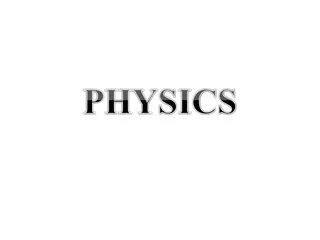Understanding Frames of Reference in Physics
Explore the concept of Frames of Reference (IFORs and NIFORs) in physics, including laws of motion, Inertial and Non-Inertial Frames, Fictitious Forces, and examples like the accelerometer in NIFOR. Learn how these concepts help explain motion and forces in different reference frames.
Download Presentation

Please find below an Image/Link to download the presentation.
The content on the website is provided AS IS for your information and personal use only. It may not be sold, licensed, or shared on other websites without obtaining consent from the author. Download presentation by click this link. If you encounter any issues during the download, it is possible that the publisher has removed the file from their server.
E N D
Presentation Transcript
Frames of Reference IFORs and NIFORs
What do you think? https://www.youtube.com/watch?v=b14l3-A8iUQ
Law of Inertia An object in motion wants to stay in motion, an object at rest wants to stay at rest An unbalanced force can change the state of motion of an object
IFOR Inertial Frame of Reference A frame in which the law of inertia and Newton s laws are valid Any frame of reference moving at constant velocity or at rest
NIFOR Non-Inertial Frame of Reference Law of inertia and Newton s laws are violated FOR is accelerating
Fictitious Force When in a NIFOR, we create a fictitious (made-up) force to explain why an object would change it s motion without a force actually applied
Accelerometer in NIFOR In a NIFOR, an object at rest will read a non-zero acceleration Think of an accelerometer in a car accelerating from a red light. Where can we see a fictitious force?
NIFOR Example You are standing on a bus as it is travelling along a street at a constant velocity (IFOR). The bus slams on it s brakes (NIFOR). The person beside you, from your perspective moves towards the front of the bus (as if a force is applied) but there is no force applied The object changes it s motion without a force applied, therefore violating law of inertia (N 1st)
Sometimes its easier to deal with a fictitious force than to look at things from an Inertial Frame of Reference
FBD in a NIFOR 1) Draw a FBD of a ball sitting on the floor of the bus (FOR) as the bus accelerates
FBD in a NIFOR 2) Draw a FBD of a ball hanging from your rear view mirror as you move around a corner
Ch.2 Review: Try Self Quiz p115 Q1 -21 Pg 117 Q8,10,15,16,17,25,28,29






















